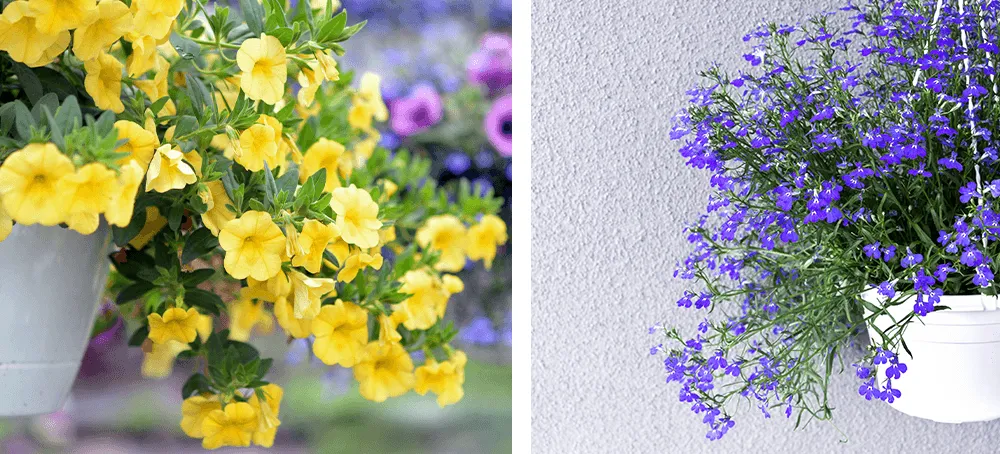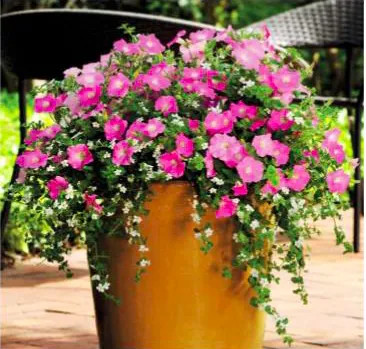Everything You Need to Know About Cascading Flowering Plants
If you’re interested in adding some lovely hanging flowers to your garden or home, cascading flowering plants are an excellent option to consider. In this article, I’ll cover the different types of cascading plants available, their care requirements, and tips for successful growth based on my own gardening experiences. By the end, you’ll have all the knowledge you need to pick out the perfect trailing bloomers for your space.
Types of Cascading Flowering Plants
There are many varieties of plants that vine or trail beautifully over the sides of containers, hanging baskets, or garden walls. Here are some of the most popular:
- Petunias – These annuals come in a huge array of colors and offer non-stop blooms from summer through fall. They’re very hardy and thrive in full sun.
- Begonias – Both fibrous and tuberous begonias cascade elegantly with colorful blooms. Make sure to give them partial shade.
- Ivies – English ivy is evergreen with few flowers, but Swedish ivy has beautiful yellow blooms. Great for shade.
- Vincas – Also called periwinkles, vincas display blue, pink, or white flowers consistently. Versatile growers.
- Million bells – These Calibrachoa have tiny blooms in a huge range of hues. Very heat and drought tolerant.
There are also great options like fuchsias, bacopas, linarias, and lantanas that thrive when planted cascading down or over the edges of containers and walls.
Care Requirements
While requirements can vary between specific types of plants, in general cascading flowers will do best if provided with:

- At least 6 hours of direct sun per day
- Welldraining soil that doesn’t stay soggy
- Regular watering to keep the soil moist
- Fertilizer monthly during the growing season
- Pruning to shape the plant and encourage more blooms
- Protection from harsh winds or frost if growing as an annual
The key is giving them conditions where they can hang freely without stress. With the right care, they’ll reward you with months of colorful flowers!
Planting and Maintenance Tips
Here are some additional tips that can help ensure your cascading flowers thrive:
- Choose a location with the recommended sunlight and space to cascade fully without touching the ground
- Use a container at least 12 inches deep, or build up a hanging basket, to provide enough root space
- Add gravel or rocks on top of the soil to prevent it from falling out of hanging pots
- Stake or trellis trailing plants at first until vines become established to take the shape you want
- Pinch back new growth occasionally to promote branching and more flower production
- Monitor for pests and diseases. Isolate and remove any affected areas right away
- Cut back by one-third after initial blooming to refresh plants and extend flowering
- Enjoy your colorful display! Reward yourself with the stunning results.
With a little TLC, cascading flowers will reward you with months of beauty. They add such lively movement and charm wherever they’re planted. I hope these tips give you some ideas to find the perfect trailing bloomers for your space!
Dealing with Challenges
No gardening project ever goes perfectly smoothly. Here are some common issues people face with cascading flowers and how to remedy them:

- Lack of blooms – Check watering, fertilizing, and sunlight. Blooms may be limited if conditions aren’t ideal
- Leggy growth – Pinch back stems to encourage bushier plants. Stake young vines until established
- Pests like aphids – Spray plants with insecticidal soap or neem oil. Remove affected leaves or isolate problem spots
- Powdery mildew – Prune away any white spots and improve air circulation. Some kinds are prone to it
- Soggy soil – Use a well-draining potting mix and elevate containers if needed
- Wind damage – Stake or cage newly planted areas until vines thicken. Bring in pots on windy days
With patience and quick response, you can usually get cascading flowers back on track. Don’t get frustrated – gardens take time and trial-and-error. You’ve got this!
I hope this information has given you some ideas of beautiful flowering plants to consider and solid growing tips. Feel free to experiment to see what thrives best with your conditions. Cascading blooms are sure to add delightful color wherever you decide to showcase them. Happy gardening!
Factors to Consider When Choosing Cascading Flowering Plants
| Plant | Sun Exposure | Water Needs | Bloom Time | Growth Rate |
|---|---|---|---|---|
| Petunias | Full Sun | Moderate | Spring to Fall | Fast |
| Begonias | Partial Shade | Moderate | Spring to Fall | Moderate |
| Impatiens | Partial Shade | High | Spring to Fall | Fast |
| Bacopa | Partial Sun | Moderate | Spring to Fall | Moderate |
| Lantana | Full Sun | Low | Spring to Fall | Fast |
FAQ
Will cascading plants climb walls or fences?
Most certainly, many types of flowering vines can be used to basically cover an ugly fence or bare wall. Wisteria, honeysuckle, and clematis tend to grow upwards seeking the sunlight. With the right conditions, they will practically take over whatever surface you give them to spread out on.
What kind of care do these plants need?
Cascading flowers kind of need lots of water and sunshine to thrive. You should make sure the soil stays moist for best results. Perhaps you may need to water every day if it’s very warm. Interesting fact: some clematis flowers will only bloom if they get enough sunshine each morning. So keep that in mind when placing them.

Do they continue blooming all summer?
Maybe not all summer long, but many types will offer amazing color for months on end with proper care. Wisteria blooms very briefly but its large clusters of flowers are stunning when they appear in spring. Honeysuckle keeps things interesting by blooming from about June until early fall. Seems like they time it perfectly to always have something in flower! Some expert gardeners suggest cutting faded blossoms to encourage reblooming.
What’s the best way to plant them?
I’d suggest putting them in spots that get full sun if possible. The soil needs to drain well so avoid low spots that don’t dry out. You’ll want to dig a hole that’s about twice as wide as the root ball but not too deep. Place the plant in the hole, fill with soil and water thoroughly. Stake if needed until roots are established. Does that help get them off to a good start? Let me know if you have any other questions!
Can deer or rabbits eat these plants?
Ugh, deer and rabbits can definitely cause problems for bloomers if given the chance. Certain varieties like clematis and honeysuckle appear to be real tasty treats for those critters. Maybe try sprinkling repellents around or putting up a fence as a deterrent if wildlife is an issue in your area. Personally I’d be so bummed if my flowers got chomped after putting in all that work. Stay strong, my gardening friends!
What kinds of pests might affect them?
Unfortunately pests and diseases can plague any plant. Cascading flowers are susceptible to things like spider mites, aphids, powdery mildew and more. Keep an eye out for signs of an infestation like leaf spots or bugs crawling around. You can sometimes control minor issues by hosing plants off regularly. Though for major infections, sadly you may need to prune or even remove diseased parts. It’s always better to take preventative measures by choosing resistant varieties when possible.

Are some varieties better than others for my zone?
Zone hardiness is definitely something to take into account when selecting vines. Check online planting guides or talk to your local garden center for advice on varieties suited to your climate. Wisteria is a poor choice for colder spots up north, but clematis comes in many heat tolerant types. Consider your winter lows before going all in on a particular flower. With a bit of research, there ought to be a few options that’ll thrive where you live.
Any final tips before I get started?
In summary – give your cascading plants lots of sun, keep the soil moist, stake if necessary and prune faded blooms regularly to prolong the show. Hopefully this FAQ helped explain some basics. But if you have any other questions, experts at your garden store or local extension office would likely be glad to offer guidance. You know what they say – the best way to learn is by trying, so have fun with your first flowering vines!
